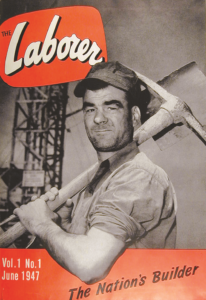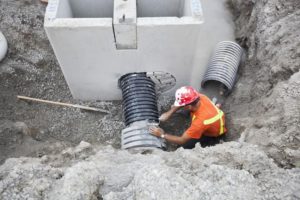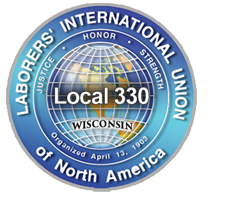LiUNA
The Laborers’ International Union of North America—is the most progressive, aggressive and fastest-growing union of construction workers, and one of the most diverse and effective unions representing public service employees.
LIUNA members are on the forefront of the construction industry – a sector that is a powerhouse of 12 million workers producing 5 percent of our countries’ economic output.
A half-million strong, we are united through collective bargaining agreements which help us earn family-supporting pay, good benefits and the opportunity for advancement and better lives.
LIUNA
905 16th Street, Northwest, Washington, DC 20006
Phone: 202-737-8320 | Website: http://www.liuna.org
History
Born of strife and struggle, LIUNA members have been uniting for better lives since the 1836 when the first recognized Laborers union was established in Philadelphia. Hundreds of Laborers Local Unions existed across North America at the turn of the century but they were only admitted to the early AFL as “Federal Locals.”
 But in 1903, Samuel Gompers, President of the American Federation of Labor (AFL), sent out a convention call to independent local Laborers’ Unions, urging them to join together and establish an international union of construction laborers. On April 13, the International Hod Carriers and Building Laborers’ Union (IHC and BLC) was founded. The first convention, held in Washington, D.C., was attended by 25 delegates from 23 Local Unions in 17 cities, representing 8,186 Laborers. A Declaration of Principles was adopted during the first convention. The delegates elected Herman Lilien, a Belgian immigrant from Chicago Local Union 4, as General President. He served as General President until 1905.
But in 1903, Samuel Gompers, President of the American Federation of Labor (AFL), sent out a convention call to independent local Laborers’ Unions, urging them to join together and establish an international union of construction laborers. On April 13, the International Hod Carriers and Building Laborers’ Union (IHC and BLC) was founded. The first convention, held in Washington, D.C., was attended by 25 delegates from 23 Local Unions in 17 cities, representing 8,186 Laborers. A Declaration of Principles was adopted during the first convention. The delegates elected Herman Lilien, a Belgian immigrant from Chicago Local Union 4, as General President. He served as General President until 1905.
The first Constitution was published in three languages: English, German and Italian. The Charter application claimed jurisdiction over the following:
- Wrecking of buildings
- Excavation of buildings
- Digging of trenches, piers, foundations, holes, lagging and sheeting of excavations
- Concrete installation of floors, foundations or any other (by hand or any other process), signaling, handling of concrete buckets
- Tending Masons & Plasterers — mixing, handling all materials, building scaffolding, building of proofing centers, drying of masonry and plaster
- Tending Carpenters
- Clearing debris from buildings
- Shoring, underpinning and renovating of old buildings
- Handling of dimension stones
Domenic D’Alessandro, from Boston Local Union 209, was elected General President in 1908 after serving as a general organizer and International Vice President. D’Alessandro left a lasting imprint on the young union serving as General President for 18 years until his death in 1926.
During his time as General President, D’Alessandro guided the union through tremendous growth as well as jurisdictional victories from rival construction trades unions.
The union’s official Journal detailed early wage rates.
In 1912, the young union went through two name changes becoming the International Hod Carriers and Common Laborers of America and then the International Hod Carriers’ Building and Common Laborers of America. A hod is a tray or trough that has a pole handle and that is used to shoulder loads of materials such as mortar or brick on a construction site.
In 1920, the union had 548 Local Unions with a membership of 96,143. Through his leadership the union supported the rights of African-American trade unionists to be accepted as equals.
LiUNA Full History ~ Read More
The LIUNA Difference
From pay to training to retirement, LIUNA members live better.
Men and women working in the construction industry see the difference a union makes in every paycheck.
- The average wage for a union-worker is $28.08, compared with $18.10 for a non -union worker, according to the U.S. Bureau of Labor Statistics.
- A heavy-highway LIUNA worker averages $41.94 an hour in wages and benefits, compared to $18.93 for non-union Laborers, according to Engineering News Record’s Construction Economics Department.
A union helps neutralize pay discrimination. The most recent report from the Bureau of Labor Statistics shows:
- For women in a union, the weekly pay advantage is 32% over non-union women in the workforce.
- For Hispanic union workers, the weekly pay advantage is 42%.
- For African American union workers, the weekly pay advantage is 33%.
LIUNA has one of the best continuing FREE education systems in the world.
- With dozens of courses that open the door to new opportunities and provide members with valuable skills.
- Classes are available in every state in the U.S. and every province in Canada.
LIUNA members are safer on the job.
- Members are empowered with the ability to speak out about workplace hazards.
- Members are provided with training in order to recognize potential hazards.
- A recent study found that the construction fatality rate in states with high union membership is half that of states with lower union membership.
Workers within a union also have an advantage when it comes to HEALTHCARE and RETIREMENT. The Bureau of Labor Statistics National Compensation Survey reports:
- 85% of union workers have health care insurance which includes medical, dental, vision and prescription drugs compared to the 54% of non-union workers.
- 76% of union workers have a guaranteed defined-benefit pension plan while only 16% of non-union workers have a pension plan.
Leadership
 Members are the key to LIUNA’s strength. They choose the union’s leaders and leaders are accountable to them.
Members are the key to LIUNA’s strength. They choose the union’s leaders and leaders are accountable to them.
Members run LIUNA, electing officers at all levels and participating in the day-to-day affairs of their Local Unions. Members set priorities for contracts and are the key in the union’s growth and success at increasing market share and political strength.
The mission of LIUNA is implemented through nine Regions, more than 40 District Councils, and more than 400 Local Unions. Workers are members of Local Unions. Local Unions work together in District Councils, which are assisted by Regional offices.
In 2001, delegates elected Terry O’Sullivan, General President and Armand E. Sabitoni General Secretary-Treasurer. In 2006 and again in 2011, delegates re-elected both to office, as well as the General Executive Board.






Join Us – Social Media